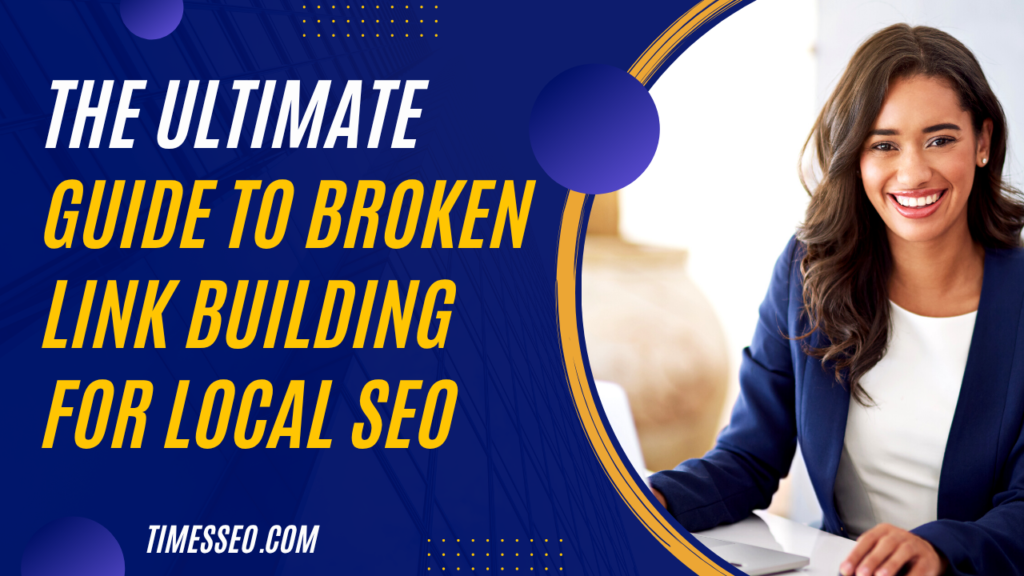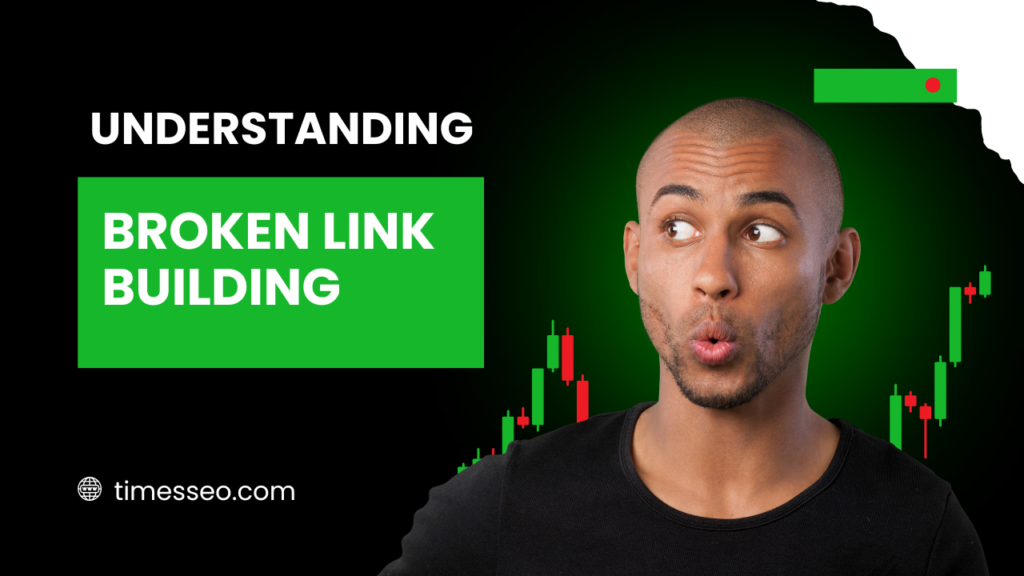
The Ultimate Guide to Broken Link Building for Local SEO
Discover how to employ broken link building for local SEO to raise your website’s authority, get helpful backlinks, and raise your rankings in local searches. This ultimate guide walks you through proven strategies, tools, and outreach techniques tailored specifically for local businesses looking to grow online.
Table of Contents
Introduction
Let’s face it—nobody likes clicking on a link that leads to a dead end. It’s frustrating for users and damaging for website owners. That’s where broken link building comes in—and if you’re aiming to boost your local SEO, this strategy is your secret weapon. This guide is your ultimate playbook on how to use broken link building to dominate local search results and build strong, local connections.
Understanding Broken Link Building
The Concept Behind It
Finding broken (dead) outbound links on websites and replacing them with your own functional content is known as broken link building. Instead of just hoping people find your content, you’re plugging a hole in their site and gaining a backlink in return.
How Broken Links Affect SEO
Broken links harm user experience, reduce crawlability, and can drag down a website’s SEO rankings. Google notices when pages are littered with dead links—and not in a good way.
Benefits of Fixing and Replacing Broken Links
- You provide value by helping webmasters fix their sites.
- You earn relevant, high-quality backlinks.
- You build local trust and authority.
Why Broken Link Building Works for Local SEO
Establishing Local Authority
When you replace dead links on local blogs, directories, or news sites, you’re inserting your brand into relevant, geographically specific spaces—making you more visible to local audiences.
Improving User Experience
Smooth navigation keeps visitors engaged longer. The better the experience, the better the signals sent to search engines.
Boosting Local Search Rankings
Local backlinks are a known ranking factor. Google gives more weight to backlinks from geographically relevant sources.
Tools You Need for Broken Link Building
Free Tools
- Check My Links (Chrome Extension)
- Broken Link Checker (Online Scanner)
- Google Search Operators for manual link finding
Paid Tools
- Ahrefs – Best for backlink analysis and broken link reports
- SEMrush – Comprehensive local SEO tracking
- Screaming Frog – Great for deep technical audits
Chrome Extensions
- LinkMiner
- SEOquake
- Hunter (for finding outreach emails)
Step-by-Step Guide to Broken Link Building
Step 1: Identify Relevant Local Websites
Target sites with local traffic—think city directories, local blogs, educational institutions, event pages, and nonprofits in your region.
Step 2: Scan for Broken Links
Use tools like Ahrefs’ Broken Backlinks report or run Screaming Frog to crawl the site and find 404 errors.
Step 3: Create High-Quality Replacement Content
Craft a piece that matches the topic and adds even more value. The better your content, the more likely you’ll earn the link.
Step 4: Reach Out to Website Owners
Send them a customized email informing them of the broken link and politely offering your material as an alternative. Keep it brief and helpful.
Crafting the Perfect Outreach Email
Email Subject Line Best Practices
- “Quick Fix for a Broken Link on Your Site”
- “Spotted a Broken Link – Thought I’d Help”
Templates That Actually Work
“Hi [Name],
I was browsing your [Page Name] and noticed a broken link pointing to [Old URL]. I recently created a similar resource that might be a great replacement. You are welcome to visit it at [Your URL].
Best, [Your Name]”
Personalization Tips
- Mention their name, website, or a recent article
- Be genuinely helpful, not salesy
Types of Content That Work Well for Broken Link Replacement
Local Guides and Resources
E.g., “Top 10 Restaurants in [Your City]” or “How to Register Your Business in [City Name]”
Blog Posts and How-Tos
Tutorials, checklists, or service explainers relevant to your niche and location
Infographics and Visual Assets
Offer eye-catching content that’s easy to link to and hard to ignore
Finding Link Opportunities Locally
Local Directories and Chambers of Commerce
Check if they’ve listed old businesses or resources—pitch your updated version.
Local Blogs and News Outlets
Smaller publications often have outdated pages with dead links—perfect for outreach.
Local Events and Sponsorship Pages
Expired event pages are treasure troves for broken links. Offer evergreen content as a fix.
Common Mistakes to Avoid
Mass Emailing Without Customization
Avoid sending the same email to everyone. Personalize to build trust.
Offering Irrelevant Content
Don’t just push any article. Make sure your material aligns with the topic of the original link.
Ignoring the UX Impact
Always make sure your suggested page improves the visitor’s experience.
Measuring the Success of Your Broken Link Building
Key Metrics to Track
- Number of links acquired
- Referral traffic increase
- Local keyword ranking boost
Using Google Search Console
Monitor backlinks and page performance.
Backlink Analysis with Ahrefs or SEMrush
Track which broken links were successfully replaced and what kind of traffic they’re generating.
How Often Should You Do Broken Link Building?
Monthly Link Audits
Make it a routine part of your SEO workflow.
Seasonal Campaigns
Target local content updates around holidays, events, and business seasons.
Scaling Your Broken Link Building Strategy
Automating with Tools
Use CRM tools like BuzzStream or Mailshake to manage outreach at scale.
Hiring Freelancers or Agencies
Consider SEO agencies that specialize in link building if you want a hands-off approach.
Broken Link Building vs Other Link Building Methods
Guest Posting
More effort, but also more control over content placement.
Resource Page Outreach
Similar concept, but not always broken—more of a pitch.
HARO (Help a Reporter Out)
Great for PR but less predictable for local links.
Case Study: Local SEO Success Through Broken Links
Before and After Metrics
A local HVAC company fixed 5 broken links and saw:
- 37% increase in organic traffic
- 4 new top-5 Google rankings
- 22% more local inquiries in 60 days
Strategy Breakdown
They targeted expired content on local directory pages and city business blogs and replaced the dead links with updated service pages.
Conclusion
Broken link building is a highly effective, often underrated strategy—especially for those chasing local SEO dominance. It’s like digital recycling—turning someone else’s trash (dead links) into your treasure (backlinks). With the right tools, a personalized touch, and a focus on value, you can turn broken links into powerful local ranking assets.
Frequently Asked Questions
Using tools like Ahrefs or Check My Links Chrome Extension is the fastest way to spot broken links on any page.
Absolutely! With constant content decay online, broken link building remains a relevant and valuable tactic.
Be helpful, polite, and brief. Offer high-quality, relevant content that makes their page better.
Yes, using tools like BuzzStream or Mailshake for outreach and Ahrefs for discovery can streamline the process.
Focus mostly on local websites for local SEO, but don’t ignore regional or niche-specific opportunities with local relevance.
Table of Contents
Popular Posts
-
 Affordable Technical SEO Audit for Small Business: A Complete Guide26 Jun 2025 Blog
Affordable Technical SEO Audit for Small Business: A Complete Guide26 Jun 2025 Blog -
 How to Get an Affordable Technical SEO Audit for Small Business27 Jun 2025 Blog
How to Get an Affordable Technical SEO Audit for Small Business27 Jun 2025 Blog -
 The Ultimate Local SEO Audit Checklist for Startups28 Jun 2025 Blog
The Ultimate Local SEO Audit Checklist for Startups28 Jun 2025 Blog -
 Local SEO Audit Checklist for Startups: A Beginner’s Guide28 Jun 2025 Blog
Local SEO Audit Checklist for Startups: A Beginner’s Guide28 Jun 2025 Blog -
 Top On-Page SEO Audit Steps for Service Websites Every Business Should Know29 Jun 2025 Blog
Top On-Page SEO Audit Steps for Service Websites Every Business Should Know29 Jun 2025 Blog -
 Technical SEO for WordPress: The Ultimate Beginner’s Guide01 Jul 2025 Blog
Technical SEO for WordPress: The Ultimate Beginner’s Guide01 Jul 2025 Blog -
 The Impact of On-Page SEO Audit Steps for Service Websites on UX01 Jul 2025 Blog
The Impact of On-Page SEO Audit Steps for Service Websites on UX01 Jul 2025 Blog -
 Technical Mobile SEO Audit Tips for Developers02 Jul 2025 Blog
Technical Mobile SEO Audit Tips for Developers02 Jul 2025 Blog -
 Complete SEO Backlink Audit Guide for Better Google Rankings03 Jul 2025 Blog
Complete SEO Backlink Audit Guide for Better Google Rankings03 Jul 2025 Blog -
 Boost Your Rankings with Technical SEO for WordPress01 Jul 2025 Blog
Boost Your Rankings with Technical SEO for WordPress01 Jul 2025 Blog






